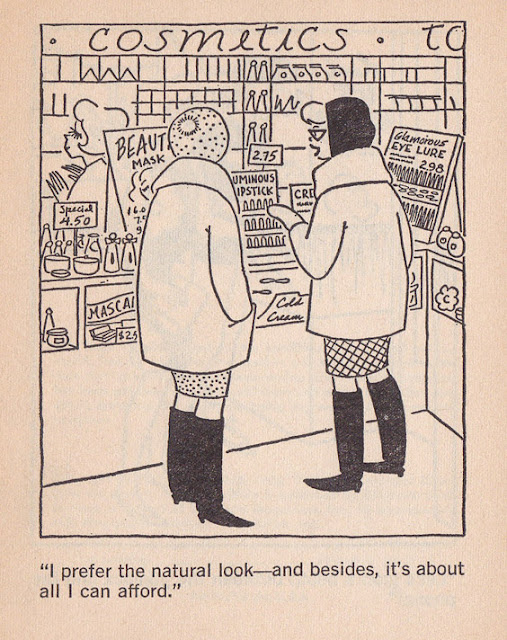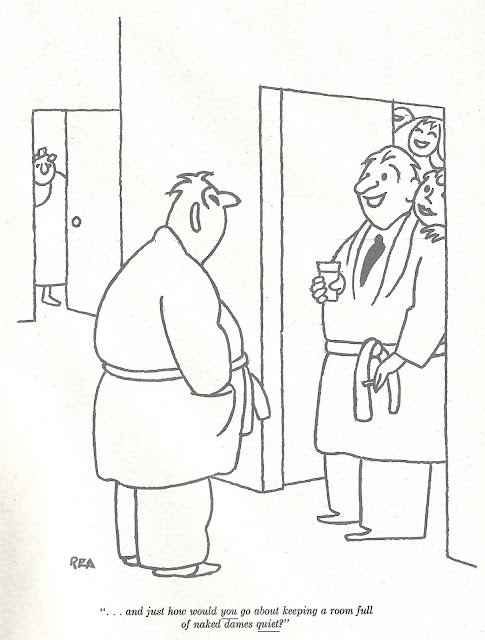Some sketches from the last month. All are on the run, drawn in my sketchbook, usually while waiting for a plane or a bus ....
Overheard at a diner this past weekend. “I saw these high school kids on
TV. They don’t even know WHO we were fighting in World War Two.”
Friday, May 31, 2019
Thursday, May 30, 2019
Tizzy by Kate Osann
Kate Osann was, like a lot of New Yorkers, a Midwestern transplant. Born in St. Louis, MO, she would graduate from Hunter College. She got a job drawing advertising illustration for the Saturday Evening Post and Colliers. It was in the 1950s that she created Tizzy, a panel cartoon that appeared exclusively in Collier's Weekly until that magazine's demise in 1957. The same year, Newspaper Enterprise Association picked up her panel for syndication. The feature, which was about an typical teenage girl, would run until 1970.
Three books of collected panels were published, reprinting the strip: Tizzy: That Loveable, Laughable Teen-Ager (Berkeley, 1958), More Tizzy (Berkeley, 1958), and Tizzy (Scholastic Book Services 1967).
She married William O. Chessman and would live in Bronxville, NY and then move to Orlando, FL. They had "two large and vocal children," William and Kathy. At Syracuse University, seven boxes of her originals are deposited.
Here are some of her panels from the 1967 Tizzy collection. It's copyright that year by NEA.
-- This is an edited version of a blog entry that originally appeared April 10, 2018.
Wednesday, May 29, 2019
Gladys Parker: A Life in Comics and A Passion for Fashion by Trina Robbins
A new biography of cartoonist Gladys Parker by cartoonist and historian Trina Robbins is coming from Hermes Press.
From the press release:
From the press release:
Gladys Parker: A Life in Comics and A Passion for Fashion
Hermes Press is coming to slay the fashion industry- with some HERstory! Gladys Parker: A Life in Comics and A Passion for Fashion explores the history behind Mopsy and her creator Gladys Parker! This beautiful book will also provide a rarely seen collection of Mopsy stories and many of Parker’s earlier strips.
Cartoonist Gladys Parker was unique in comics. As with Frida Kahlo, it was impossible to tell where her art left off and its creator began. Parker mixed fashion and comics and created classic characters that mimicked her sense of fashion. In fact, Parker was an exact double for her ink-and-paper creation, Mopsy.
Tarpe Mills and Dale Messick both dressed to kill and included paper dolls featuring their heroines’ chic 1940s wardrobes. Tarpe Mills and Lily Renee were fashion models before they drew comics. But only Gladys Parker (and one other)* was a fashion designer with a successful line of clothing while at the same time drawing an equally successful comic strip. Parker’s dresses bearing the Gladys Parker label were sold at her own New York shop and at high-end department stores across the country – and she also found the time to costume Hollywood movies and the beauties that starred in them!
Who better to chronicle the story of Gladys Parker than comics herstorian Trina Robbins, who in the 1960s designed clothes for hippies and rock stars out of her East Village boutique, while drawing underground comix?
ISBN: 978-1-61345-181-6
Tuesday, May 28, 2019
From the Dick Buchanan Files: Gag Cartoon Clichés Part 9 1937 - 1968
Courtesy of the massive gag cartoon clip files of Dick Buchanan, here are some more gag cartoon clichés. This is part nine of this study, and there are links to other samples that Dick has culled below. My goodness, go and see! My thanks to him for this and -- take it away, Mr. B:
---
GAG CARTOON CLICHES Part Nine
(1937 - 1968)
The Cartoon Clip File continues the task of surveying gag cartoon clichés prevalent during the mid-20th Century. We began compiling this illustrated list when confronted with a list of 100 Gag Cartoon clichés more than a year ago. Over time we have used this list as a guide, finding typical examples of gag cartoons from the great magazines of the era. Our research also uncovered several examples of clichés which were not on the list so we have added them to this accounting, creating the Cartoon Clip File Cliché Compendium. Here is the latest installment . . .
THE LOUD PARTY.
1. CLYDE LAMB. 1000 Jokes Magazine August-October, 1954.
2. ELMER ATKINS. Collier’s April 16, 1954.
3. GARDNER REA. 1000 Jokes Magazine March-May, 1964.
NOAH’S ARK.
1. ORLANDO BUSINO. Boys’ Life November, 1968.
2. CLYDE LAMB. American Legion Magazine December, 1953.
3. A.F. WILES. Punch July 2, 1958.
HUSBANDS COMING HOME LATE.
1. BILL YATES. American Legion Magazine January, 1956.
2. GEORGE CRENSHAW. 1000 Jokes Magazine Winter, 1950.
3. ROBERT CHURCHILL. The Saturday Evening Post February 24, 1951.
BEDTIME STORIES.
1. PERRY BARLOW. Collier’s June 2, 1937.
2. SALO ROTH. The Saturday Evening Post July 30, 1949.
3. ROLAND COE. Collier’s August 1, 1942.
PERFUME COUNTER.
1. REAMER KELLER. Judge March, 1947.
2. GEORGE DOLE. The Saturday Evening Post August 28, 1965.
3. BOB WEBER. True August, 1962.
Need more?
Gag Cartoon Clichés Part 1
Gag Cartoon Clichés Part 2
Gag Cartoon Clichés Part 3
Gag Cartoon Clichés Part 4
Gag Cartoon Clichés Part 5
Gag Cartoon Clichés Part 6
Gag Cartoon Clichés Part 7
Gag Cartoon Clichés Part 8
---
GAG CARTOON CLICHES Part Nine
(1937 - 1968)
The Cartoon Clip File continues the task of surveying gag cartoon clichés prevalent during the mid-20th Century. We began compiling this illustrated list when confronted with a list of 100 Gag Cartoon clichés more than a year ago. Over time we have used this list as a guide, finding typical examples of gag cartoons from the great magazines of the era. Our research also uncovered several examples of clichés which were not on the list so we have added them to this accounting, creating the Cartoon Clip File Cliché Compendium. Here is the latest installment . . .
THE LOUD PARTY.
1. CLYDE LAMB. 1000 Jokes Magazine August-October, 1954.
2. ELMER ATKINS. Collier’s April 16, 1954.
3. GARDNER REA. 1000 Jokes Magazine March-May, 1964.
NOAH’S ARK.
1. ORLANDO BUSINO. Boys’ Life November, 1968.
2. CLYDE LAMB. American Legion Magazine December, 1953.
3. A.F. WILES. Punch July 2, 1958.
HUSBANDS COMING HOME LATE.
1. BILL YATES. American Legion Magazine January, 1956.
2. GEORGE CRENSHAW. 1000 Jokes Magazine Winter, 1950.
3. ROBERT CHURCHILL. The Saturday Evening Post February 24, 1951.
BEDTIME STORIES.
1. PERRY BARLOW. Collier’s June 2, 1937.
2. SALO ROTH. The Saturday Evening Post July 30, 1949.
3. ROLAND COE. Collier’s August 1, 1942.
PERFUME COUNTER.
1. REAMER KELLER. Judge March, 1947.
2. GEORGE DOLE. The Saturday Evening Post August 28, 1965.
3. BOB WEBER. True August, 1962.
Need more?
Gag Cartoon Clichés Part 1
Gag Cartoon Clichés Part 2
Gag Cartoon Clichés Part 3
Gag Cartoon Clichés Part 4
Gag Cartoon Clichés Part 5
Gag Cartoon Clichés Part 6
Gag Cartoon Clichés Part 7
Gag Cartoon Clichés Part 8
Friday, May 24, 2019
Video: Brian Walker "Cartooning and Comic Strips: The Essence of the Art"
From 2016: This historic lecture by cartoon historian and Beetle Bailey artist
Brian Walker took place at the opening of the Billy Ireland Cartoon
Library & Museum at Ohio State University.
Thursday, May 23, 2019
From the Dick Buchanan Files: Color Gag Cartoons 1946 - 58
Some rare, vintage color magazine cartoons from the Greenwich Village single panel collection of Dick Buchanan's. Thank you very much for sharing these rarities, and take it away, Dick:
---
COLOR CARTOONS
(1946 – 1958)
Although comic strips were published in color from the beginning, gag panel cartoons did not follow suit. Cartoons were an important feature of magazine covers such as Puck, Judge, Life and The New Yorker. But interior gag panel cartoons did not appear in color until the early 1930’s when Collier’s and The Saturday Evening Post began publishing them occasionally. The New Yorker eschewed the interior color cartoon, with editor Harold Ross famously exclaiming “What’s so funny about red?” Whether or not red is a funny color is debatable, right along with other discussions about what is the funniest number, the funniest fruit or the funniest animal. Be that as it may, here is a collection of 20th Century gag cartoons in color. One is in colour.
As always, these are examples of some fine work by the best cartoonists from the “Golden Age of Gag Cartooning.”
1. ELDON DEDINI. Esquire July, 1955.
2. CHON DAY. Collier’s August 2, 1952.
3. DAVE GERARD. Collier’s July 8, 1950.
4. KATE OSANN. Collier’s August 2, 1952.
5. REAMER KELLER. American Magazine circa 1950’s.
6. BOB BARNES. Collier’s August 9, 1952.
7. RODNEY deSARRO. The Saturday Evening Post January 11, 1947.
8. JERRY MARCUS. The Saturday Evening Post April 27, 1957.
9. GARRETT PRICE. Collier’s August 2, 1952.
10. MARTIN GIUFFRE. American Magazine July, 1953.
11. STAN FINE. Collier’s March 28, 1953.
12. STAN and JANICE BERENSTAIN. Collier’s January 17, 1953.
13. WILLIAM von RIEGEN. Collier’s December 16, 1950.
14. MICHAEL BERRY. Esquire May, 1946.
15. RUSSELL BROCKBANK. Punch Almanac 1959. Punch November 3, 1958.
---
COLOR CARTOONS
(1946 – 1958)
Although comic strips were published in color from the beginning, gag panel cartoons did not follow suit. Cartoons were an important feature of magazine covers such as Puck, Judge, Life and The New Yorker. But interior gag panel cartoons did not appear in color until the early 1930’s when Collier’s and The Saturday Evening Post began publishing them occasionally. The New Yorker eschewed the interior color cartoon, with editor Harold Ross famously exclaiming “What’s so funny about red?” Whether or not red is a funny color is debatable, right along with other discussions about what is the funniest number, the funniest fruit or the funniest animal. Be that as it may, here is a collection of 20th Century gag cartoons in color. One is in colour.
As always, these are examples of some fine work by the best cartoonists from the “Golden Age of Gag Cartooning.”
1. ELDON DEDINI. Esquire July, 1955.
2. CHON DAY. Collier’s August 2, 1952.
3. DAVE GERARD. Collier’s July 8, 1950.
4. KATE OSANN. Collier’s August 2, 1952.
5. REAMER KELLER. American Magazine circa 1950’s.
6. BOB BARNES. Collier’s August 9, 1952.
7. RODNEY deSARRO. The Saturday Evening Post January 11, 1947.
8. JERRY MARCUS. The Saturday Evening Post April 27, 1957.
9. GARRETT PRICE. Collier’s August 2, 1952.
10. MARTIN GIUFFRE. American Magazine July, 1953.
11. STAN FINE. Collier’s March 28, 1953.
12. STAN and JANICE BERENSTAIN. Collier’s January 17, 1953.
13. WILLIAM von RIEGEN. Collier’s December 16, 1950.
14. MICHAEL BERRY. Esquire May, 1946.
Subscribe to:
Comments (Atom)


























































